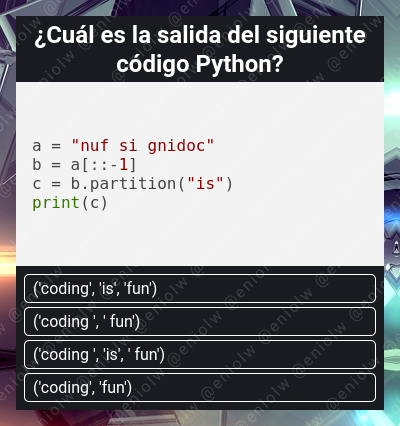My Coding Quiz #19 👨💻🛠️🧩
Welcome to the new installment of my series of Coding Quizzes, in which you will be able to test your knowledge and skills about programming and software development in a simple and fun way. If you want to learn more about it visit my blog here on Hive and the first post where I introduced it.
Without further ado, here's the riddle...

By @eniolw
What's your choice?
Solution to the previous quiz: 4. Line 1 defines an list of characters a = ['0', '1', '2' '3']. Note that there is no comma between '2' and '3', so they are not separate elements. In fact, when Python sees contiguous literals like this, what it does is concatenate them into one. Thus, internally the list a consists of ['0', '1', '23']. This detail will be the essence of the exercise and the solution.
Line 2 makes a copy of a and calls it b. Line 3 adds a '5' element to b with the well-known append method, and line 4 removes the element located at the index 1 from to. Finally the length of b is printed.
Since b is a copy of a and it had a length of 3 when the copy was made, only the operation at line 3 affected the length of b, because a new element was added to it. Therefore, the value of b is ['0', '1', '23', '4'], which is an array of length 4 , the output obtained.
The quiz was successfully solved by @splash-of-angs63. Good job!
If you want to blog about computer science and programming content, I invite you to join Hive and participate in its communities, such as STEM-social, Develop Spanish, Programming & Dev and others.
Mi Quiz de Programación #19 👨💻🛠️🧩
Bienvenido a mi nueva serie de Quizzes de Programación, en la cual podrás poner a prueba tus conocimientos y habilidades sobre programación y desarrollo de software de una manera sencilla y divertida. Si quieres aprender más sobre ella visita mi blog aquí en Hive y el primer post donde la presenté.
Sin más preámbulos, he aquí el acertijo...

Por @eniolw
¿Cuál es tu elección?
Solución al quiz anterior: 4. La línea 1 definie un arreglo de caracteres a = ['0', '1', '2' '3']. Nótese que no hay coma entre '2' y '3', por lo que no son elementos separados. De hecho, cuando Python ve literales contiguos así, lo que hace es concatenarlos en uno solo. Así, internamente el arreglo a consiste en ['0', '1', '23']. Este detalle será la esencia del ejercicio y la solución.
La línea 2 hace una copia de a y la llama b. La línea 3 añade un elemento '5' a b con el bien conocido método append, y la línea 4 retira el elemento ubicado en el índice 1 de a. Finalmente se imprime la longitud de b.
Como b es una copia de a y esta tenía una longitud de 3 cuando se hizo la copia, solo la operación de la línea 3 afectó la longitud de b, pues se le añadió un nuevo elemento. Por tanto, el valor de b es ['0', '1', '23', '4'], que es un arreglo de longitud 4, la salida obtenida.
El quiz fue resuelto satisfactoriamente por @splash-of-angs63. ¡Buen trabajo!
Si quieres bloguear sobre contenido informático y de programación, te invito a unirte a Hive y participar en sus comunidades, tales como STEM-social, Develop Spanish, Programming & Dev y otras.
